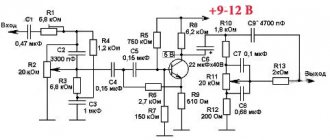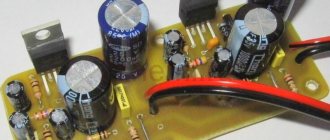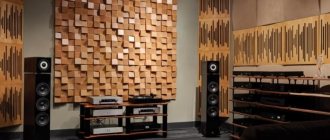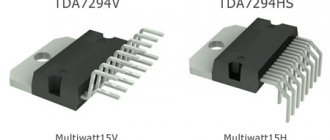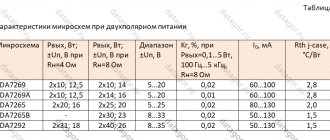The board can be used in both 2-channel and bridged mono mode. For bridge use, add a 22 kOhm resistor R3 (BTL) to the circuit. Entering bridged mode will turn on speaker OUTR1 and OUTL2. INL must be connected to GND.
Printed circuit board
Circuit board:
Appearance of the assembled board:
Author: Peter Smith (siliconchip.com.au)
The LM1875 chip is a high-quality monophonic low-frequency power amplifier capable of delivering up to 25 Watts to the load. The output stage of the microcircuit operates in class AB. The LM1875 has high sound parameters and costs significantly more than the similar TDA2030 chip, but the sound quality is definitely better than the latter.
The microcircuit is usually used in household audio systems, to power wideband speakers or low-power subwoofers.
I have repeatedly assembled and tested an amplifier based on the famous TDA2030 microcircuit. The circuit was non-standard; in addition to the microcircuit, additional transistors were used. In fact, all the power falls on the transistors, and the microcircuit itself works as a driver. I must note that the result was not very good, at maximum volume the transistors got very hot, the sound was distorted beyond recognition, if anyone decides to assemble it, then my advice is to use the circuit only for the subwoofer. A couple of days ago I decided to build a similar amplifier again, only this time I replaced the output transistors and redid the circuit, and used an LM1875 chip as a driver. With a bridge circuit, an amplifier using two LM1875 is capable of developing up to 50 Watts, and with output transistors up to 70 Watts!
The output stage uses a complementary pair of powerful bipolar transistors such as 2SA1943 and 2SC5200. This pair is used in the final stages of many transistor amplifiers, such as the LANZAR or MARSHALL LEACH circuit.
The coil is wound on a resistor and contains 10 turns of wire with a diameter of 0.8 mm. 10 Ohm resistor with 2 Watt power.
The input capacitor is to taste; for the subwoofer, film capacitors with a capacity of 1 to 4.6 μF should be used. All electrolytic capacitors must be selected with a voltage of 35 Volts or higher. If desired, you can try to replace the output transistors with domestic ones - KT818/19 with the same letters, but the power and parameters of the amplifier will drop. The amplifier is powered from a bipolar source; when powered from network power supplies, pay special attention to capacitor filters after the rectifier; to avoid network interference, you should use a capacitance of at least 10,000 uF in the arm; it is advisable to use shielded input wires.
The microcircuit itself was installed on a small separate heat sink; it works as a pre-amplifier, so it will not overheat too much. Transistors need cooling, since the entire main load is on them; they are mounted on a heat sink through an insulating gasket; for better heat transfer, thermal paste should be used.
LM1875T - integrated amplifier based on original chips
Review of the original LM1875T microcircuits and ULF based on them. The chips and other components were purchased from the Mouser Electonics radio parts store. Mouser Electronics is one of the largest distributors of electronic components. The company was founded in the USA in 1964 - en.wikipedia.org/wiki/Mouser_Electronics. Now the company is represented in many countries, there is a European (Munich) and Eastern European (Prague) representative office with its own warehouses, and there is also a Russian representative office - the PM Electronics company in St. Petersburg (https://pmelectronics.ru/). For Russians, orders are collected in Munich, then sent to PM Electronics in St. Petersburg and then sent to the buyer by courier. All cash transactions are made with PM Electronics. This is international cooperation. Pros of Mouser Electronics:
1. Huge selection of electronic components. Everything is original - the company works directly with manufacturers. 2. They work with individuals. 3. Free shipping on orders over $60. 4. An excellent and convenient site - search and selection based on various parameters of components (parameters, sizes, manufacturers, type of terminals, etc.). You can view datasheets for all components. 5. There is no charge for packing parts. 6. Possibility of selecting components in different baskets for different projects. 7. Packaging in a separate antistatic bag for each type of component.
Minuses:
1. Expensive + cheating from the Russian representative of PM Electronics. 2. Delivery after ordering - 3-4 weeks. 3. Payment immediately after ordering. 4. Sometimes the selected components are not in stock, although according to the database on the website the components are in stock. PM Electronics offers to either return the money for the components, or replace the components, or wait until they arrive at the warehouse. 5. Some components are not supplied to Russia due to sanctions. 6. For Russians, it is impossible to track the process of order formation and delivery. 7. Payment by bank transfer only.
We go to the website ru.mouser.com/ In the search we type LM1875 and get a choice:
When choosing components you need to pay attention to 1. The price. 2. Availability in stock - select only those components that are in stock. The more components in stock, the better. 3. For Europeans (and perhaps others), the location of the warehouse is important - for components in a warehouse in the USA you will have to pay additional customs duties. 4. Per manufacturer - some components are made by several different manufacturers. 5. For dimensions, pin locations, housing type, etc.
Prices for Russians and, for example, Americans are different (hello to customs duties and PM Electronics)
For Russians:
For Americans:
So, for orders priced over $100, it makes sense to order mail forwards from the USA through intermediaries.
What to order from Mauser - microcircuits, op-amps, semiconductors (original high-power transistors, diode bridges, Schottky diodes, etc.), branded capacitors ELNA, Nichicon, Wima etc.
Next, select the product and add it to the cart. Orders for free delivery must be priced over $60. After selecting all the components, go to the cart, check and confirm the order. After some time, an email arrives with an order confirmation from the Munich branch of Mouser Electronics and a message that the order has been transferred to PM Electronics. After some time (1-2 days), an email message comes from the manager of PM Electronics with an offer to pay the invoice by bank transfer within 3 days and the invoice itself. I pay from Sberbank Online by bank transfer and indicate the account number in the message. I send a photo from the screen to the manager. If everything is ok, after about two to three weeks you receive a message that the order has arrived at PM Electronics and the package is ready to be sent by courier to your city. And SMS from the courier service. After about 5-7 days, a courier appears in your city (calls your phone). Informs: ready to deliver the parcel to the address specified during registration. When the courier delivers the parcel, they don’t ask for your passport - that’s how they hand it over.
The LM1875T chip is a single-channel high-quality low-frequency amplifier of class AB with a power of up to 20 Watts - datasheet here www.ti.com/general/docs/suppproductinfo.tsp?distId=26&gotoUrl=http%3A%2F%2Fwww.ti.com%2Flit% 2Fgpn%2Flm1875
The chip came in this form:
The pins of the microcircuit are not soldered, but are scratched - my version: the microcircuit was tested on a bench before packaging.Microcircuits and other parts (op-amp, capacitors) were purchased for the power amplifier project from this topic from the Soldering Iron:
Amplifier based on LM1875 with tone block and built-in protection on one board. I ordered printed circuit boards at www.allpcb.com/ - instead of 5 pieces they sent 6 pieces - if anyone is interested in this project - write - I will send free boards. I took the Laika from the forum. The leads for some components had to be drilled out:
Soldered amplifier:
I bought the housing for the amplifier on ebay - ebay.com/itm/322538994572
Before assembly:
Inscriptions before gluing: Assembled ULF:
Measurements into an 8 ohm load. Power supply is a transformer with two windings of 12 Volts. Power Pmax=16 Watt, Pav=8Watt:
RMAA:The characteristics turned out to be quite average.
Tone Control Measurements:
Sound-wise, it plays well. There is no background, the timbre is adjustable. Distortion is not audible.
Output power depends on supply voltage:
I have a 12 V transformer. Initially, the amplifier was planned to be used for speakers from a Panasonic radio and connected to a TV instead of the TV’s built-in audio system. Hence the low power. The amplifier was 80% ready. But then life made its own adjustments. I decided to finish it anyway. So the ULF is now voicing my kitchen.
Possible replacements:
The output stage transistors can be replaced with the domestic pair KT8101/KT8102 with the letters A and B, it will work even better with them. You can try replacing it with KT818/19, as mentioned earlier, but this is not the best option. Resistors of 0.22 Ohm can be supplied to 0.33 or 0.39 Ohm 5 Watt, it is advisable to use domestic resistors, they have low inductance and a long service life, although in this circuit they do not work at the limit, so imports can be used. 0.22 µF capacitors can be used ceramic, the input capacitor is better to use a film capacitor, all these capacitors are designed for a voltage of 63 Volts or more, so there should be no problems.
